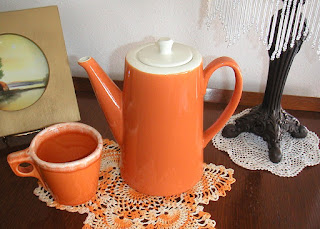Finding reusable items in second-hand stores is like going on a treasure hunt. Here are some of the things I've found over the years.
Digging through dusty bins can really pay off if you're looking for chairs, side tables, mirrors, kitchen gadgets, pots and pans, dishes, glassware, picture frames, art, tools, books and even clothes for a fraction of the original price. It's an economical way to decorate.
One of my favorite things to collect is American-made dinnerware. If you question buying used dishes, remember that when you eat at a restaurant, you're eating on dishes that have been used hundreds of times. With the right scrubbing, disinfectant and sanitation methods, they're good to go.
Cast iron skillets make great finds for cooking steaks, fried chicken, pork chops and more. Their durable construction makes the pan safe to use on the outdoor grill, over campfires or in the oven.
Look for the manufacturer's mark on the bottom for names like Wagner or Griswold.
The skillet I found was covered in years of baked-on grease. SOS pads, elbow grease and a light coating of oil made it look like new.
Second-hand stores are great place to find vintage items as people who are downsizing donate their excess household items. Goodwill, Salvation Army, Donation Station, Friends of Strays, and Junior League stores can yield treasures from dusty attics, barns, storage units and leftovers from estate sales.
Antique stores usually have a bargain area where slow-moving items are marked down. Pawn shops and flea markets have jewelry, guitars, clocks, kitchenware, appliances, tools patio furniture and more.
This Rookwood vase from 1904 is signed by its designer, KVH, for Katherine Van Horne. It's marked with the manufacturer's stamp and a Roman numeral on the bottom for the year. Vases like this can sell for hundreds to collectors. I found this one at a garage sale.
Keep an eye out for multiple-family garage sales where people are trying to get rid of grandma's "dusty old things." You never know what you might find.
Vintage Oak Washstand from the late 1800sIf you want to learn more about the history of vintage items, auctions are good places to start. An experienced auctioneer tells a story about the items to build interest from the crowd.
Auctions
- Arrive early and check out the items for sale.
- Bring a magnifying glass and a flashlight to inspect hard-to-see areas.
- Items are sold as is and where is.
- Any defects are the buyer's responsibility.
- Find out how much the auction charges for a buyer's premium. Sometimes it's ten-percent added to the winning bid amount.
Bidders are assigned a buyer's number to be used when bidding. When the bidding gets intense over an item, the price tends to go up.
Don't worry that you'll end up buying something accidentally. If there's a question of intent, the auctioneer usually asks, "Are you waving at someone or bidding?" You'll know if you've bought something when they yell, "SOLD!"
How Much Is It Worth?
Finding values is easy with an internet search. For years, collector series books were the only source for values. They're still a great source of manufacturer's history of where certain patterns originated. Remember, an item is only worth what the market will bear.
When you check eBay for an item's worth, sign in and look at the "sold" listings. Just because someone sets a sale price doesn't mean people will buy it for that much.
Hull coffee mug in tangerine (rare) color with a matching coffee server.Knowing what to buy is as important as knowing what not to buy. Here are some things best left at the store.
Things To Avoid When Shopping at Second Hand Stores
- Intimate clothing, like socks, panties, bras or swimsuits, unless tagged with original manufacturer's tags and in "new" unworn condition. Always launder before using.
- Cloth covered furniture with odors or stains are best left behind. (Crime TV makes me suspicious of red stains.)
- If it smells funny or has mold or water damage, think twice before buying it.
- Avoid books or paintings that smell of mold or mildew unless they have historical value or are family heirlooms. In that case professional restoration may be required.
- Pass on porous items like wooden spoons, wooden bowls, non-washable fabrics or other items that can't be immersed in a cleaning solution and disinfected thoroughly.
- Consumables like make-up, body lotion, perfume, edibles and other vintage food items are likely beyond their best-use date and aren't safe to eat or use. Perfume bottles can be cleaned but the contents will likely smell strong.
- Kitchen appliances need to be tested. Some items like mixers, toasters and lamps are safer if they're rewired.
- Shoes are questionable unless they show little or no wear. They can be of value as theater props or decorations.
- Some baby car seats and cribs have been recalled due to dangerous or unsafe outcomes. Check for any recalls.
- Some old items were made with paints that contained lead or radioactive materials, like illuminated clock faces painted with radium. Avoid these.
- If an item just doesn't feel right when you pick it up or holding it makes the hair on your neck stand up, leave it behind.
Use your good judgement on used items.
Good luck in your search for vintage items. I hope you find the treasure of a lifetime!
 |
| Burgundy Lace Dishes from the 40s |
 |
| Solomon Lithograph from the 40s |
 |
| Marigold Carnival Tumblers from the 60s |
 |
| Hull Mirror Brown Oven Proof Dishes USA |














































